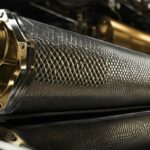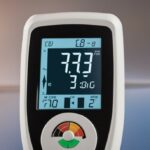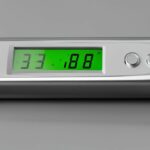Last Updated on 5 months by Francis
Regular testing of your vehicle’s catalytic converter is essential to ensure optimal performance and reduce harmful emissions. In this section, we will provide a step-by-step guide on how to test your catalytic converter using an infrared thermometer. We will explain the importance of conducting regular tests, introduce the tool required for the process, and outline the diagnostic process.
Contents
Key Takeaways
- Regular testing of your catalytic converter is necessary to maintain optimal performance and reduce harmful emissions.
- An infrared thermometer is a useful tool for testing catalytic converters, with a temperature range of up to 1,000 degrees Fahrenheit.
- Proper preparation of your vehicle before testing, including allowing it to cool down and removing obstructions, is crucial for accurate results.
- Interpreting the temperature readings correctly can help identify potential issues with the catalytic converter.
- Additional testing techniques, such as backpressure testing and exhaust gas analysis, may be necessary for more advanced troubleshooting.
Understanding Catalytic Converters and Their Function
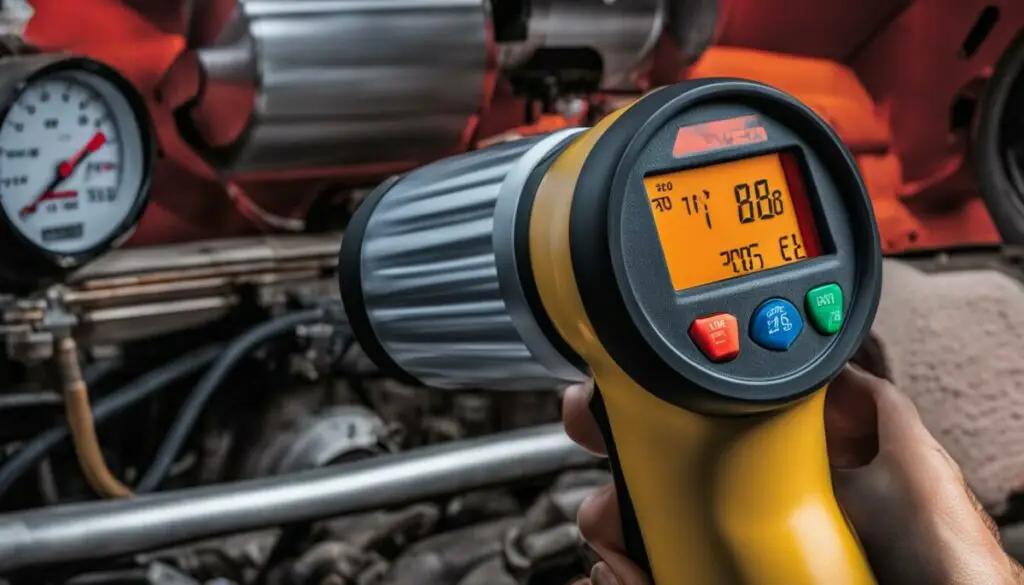
If you’re experiencing issues with your vehicle’s exhaust system, the problem may lie with your catalytic converter. A catalytic converter is a vital part of your vehicle’s emissions control system, designed to reduce harmful pollutants that are released through the exhaust system.
Located between the engine and muffler, the catalytic converter works by converting harmful pollutants such as carbon monoxide, nitrous oxide, and hydrocarbons into less harmful substances, such as carbon dioxide, nitrogen, and water vapor.
However, over time, catalytic converters can become clogged, leading to reduced efficiency and potential damage to your vehicle’s engine. This is where an infrared thermometer can be useful in troubleshooting catalytic converter issues and diagnosing problems. By measuring the temperature of the catalytic converter, you can identify potential issues and take action before the problem becomes more severe.
Diagnosing Catalytic Converter Problems
The symptoms of a malfunctioning catalytic converter can vary, but common signs include reduced engine performance, poor fuel economy, and increased emissions. By using an infrared thermometer to troubleshoot your catalytic converter, you can diagnose potential issues such as:
- Blockage or clogging
- Overheating
- Inefficient or incomplete conversion
- Physical damage or corrosion
Once you have identified these issues, you can take appropriate measures to address them, such as cleaning or replacing the catalytic converter.
Next, we will guide you through the process of selecting the right infrared thermometer for testing your catalytic converter.
Selecting the Right Infrared Thermometer

Using an infrared thermometer for catalytic converter testing requires selecting the right tool for the job. Several factors should be considered when choosing an IR thermometer for catalytic converter testing:
- Temperature range: The temperature range is a crucial factor in selecting the right infrared thermometer. Make sure the thermometer has a wide range that can measure temperatures as high as 1000 degrees Fahrenheit (538 degrees Celsius).
- Accuracy: Accuracy is key to obtaining reliable readings. Make sure the thermometer has an accuracy of at least 1% to 2%.
- Response time: A thermometer’s response time is how long it takes to register a temperature reading. Make sure the thermometer has a fast response time to get accurate readings quickly.
- Distance to spot ratio: This ratio measures the size of the area in which the thermometer can detect temperatures accurately. Make sure the thermometer has a high ratio to measure the catalytic converter’s temperature accurately.
- Ease of use: An infrared thermometer for catalytic converter testing should be easy to use. A simple design with clear instructions and buttons for turning on and off the thermometer can make the testing process smooth and effortless.
Once you have selected an IR thermometer that meets these requirements, it’s time to move on to the next step of preparing your vehicle for testing.
Selecting the Right Infrared Thermometer
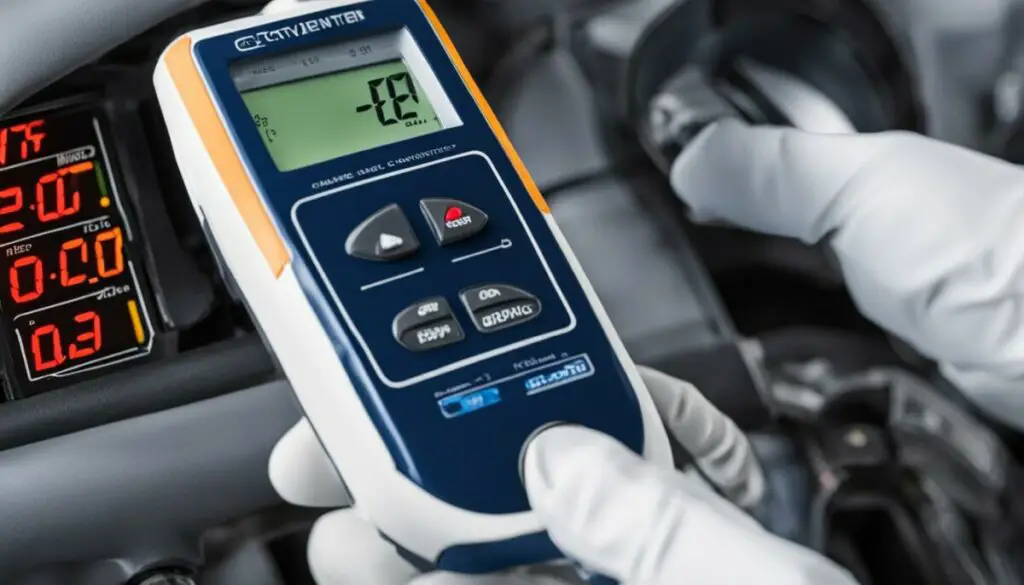
Before you can begin testing your catalytic converter, you need to select the right infrared thermometer. Here are some factors to consider:
- Temperature range: Look for an infrared thermometer that has a temperature range that covers both the ambient temperature and the temperature of the catalytic converter. This will ensure that you can get accurate readings.
- Accuracy: Choose an infrared thermometer with a high level of accuracy. Look for one with a margin of error of less than 1%.
- Ease of use: Make sure the infrared thermometer you choose is easy to use. Look for one with a clear display and intuitive controls.
Here is an example of a suitable infrared thermometer for catalytic converter testing:
| Infrared Thermometer | Features |
|---|---|
| Fluke 62 MAX+ |
|
By selecting the right infrared thermometer, you can ensure that you get accurate temperature readings when testing your catalytic converter. This will help you diagnose any potential issues and keep your vehicle running smoothly.
Performing the Initial Test
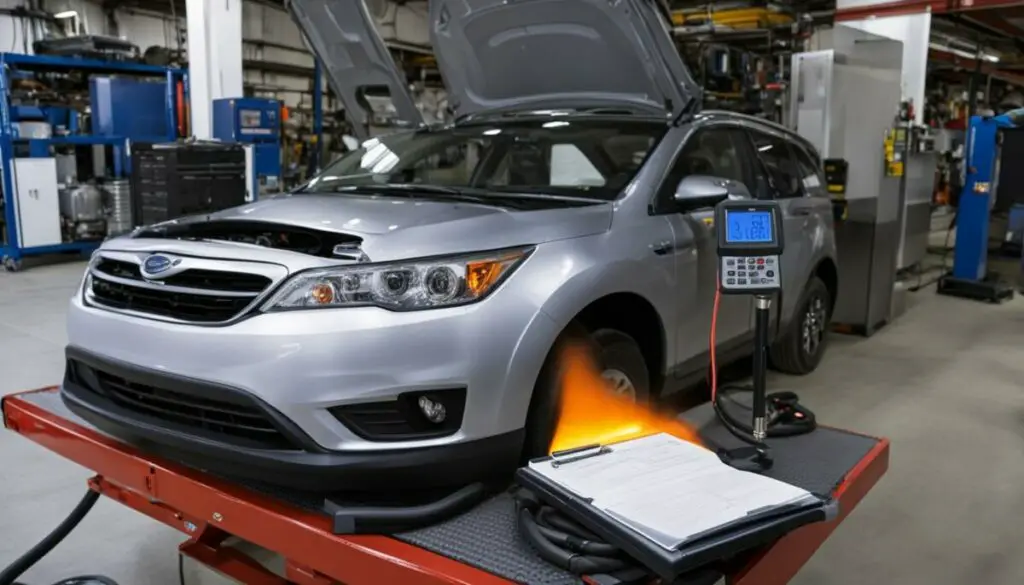
Now that you have prepared your vehicle for testing, it’s time to take initial temperature readings using the infrared thermometer. For the most accurate results, it’s recommended that the vehicle be at normal operating temperature prior to conducting the test.
Start the engine and let it idle for a few minutes. Place the infrared thermometer near the catalytic converter to obtain a temperature reading. Note the reading and compare it to the manufacturer’s specifications for your vehicle.
If the temperature reading is within the recommended range, move on to the next step. However, if the reading falls outside the recommended range, it may indicate an issue with the catalytic converter.
Quick Tip: If you’re unsure about the proper temperature range for your vehicle’s catalytic converter, consult your owner’s manual or reach out to a trusted mechanic for guidance.
Analyzing the Temperature Readings

After taking the initial temperature readings of your catalytic converter using the infrared thermometer, it’s essential to analyze them correctly. By identifying any temperature discrepancies or irregularities, you can diagnose potential issues with your catalytic converter.
The temperature readings you obtain will vary depending on the location of the device and the time of day. Typically, the catalytic converter’s temperature should be between 400 and 600 degrees Fahrenheit during normal driving conditions.
However, if you find that the temperature readings are significantly higher or lower than these values, it may be an indication of a problem with the catalytic converter.
One common issue is a clogged or contaminated catalytic converter. If the temperature readings are significantly lower than expected, it may be because the catalytic converter is not processing the exhaust gases efficiently.
On the other hand, if the temperature readings are higher than expected, it may indicate that the catalytic converter is overheating due to a buildup of exhaust gases. This could result in the breakdown of the converter’s internal components and lead to a complete failure of the device.
Troubleshooting Catalytic Converter with Infrared Thermometer
By using the infrared thermometer and analyzing the temperature readings, you can troubleshoot potential issues with your catalytic converter. If the readings indicate a problem, it’s essential to take immediate action to avoid further damage to your vehicle and potential safety hazards on the road.
However, keep in mind that the infrared thermometer test should only be used as an initial diagnostic tool. For more advanced troubleshooting, additional testing techniques may be required, as discussed in Section 8 of this guide.
“Regular testing using an infrared thermometer can help diagnose potential issues with your catalytic converter and prevent expensive repairs down the line.”
Interpreting the Diagnostic Codes

Once you have performed the infrared thermometer test on your catalytic converter, it’s essential to understand the diagnostic codes related to catalytic converter issues. The Check Engine Light (CEL) is the primary indicator of catalytic converter problems. When the CEL turns on, it means there is an issue with one or more of the car’s components, including the catalytic converter.
You can use a diagnostic scan tool to retrieve the error codes from your car’s computer system. The scan tool will provide a string of numbers and letters that correspond to the specific issue detected by the car’s computer. Based on the codes retrieved, you can identify the particular problem with your catalytic converter and the required fix.
Common Diagnostic Codes
Below are some of the common diagnostic codes related to catalytic converter issues:
| Diagnostic Code | Description |
|---|---|
| P0420 | Catalyst System Efficiency Below Threshold (Bank 1) |
| P0430 | Catalyst System Efficiency Below Threshold (Bank 2) |
| P0421 | Warm-Up Catalyst Efficiency Below Threshold (Bank 1) |
| P0431 | Warm-Up Catalyst Efficiency Below Threshold (Bank 2) |
| P0422 | Main Catalyst Efficiency Below Threshold (Bank 1) |
| P0432 | Main Catalyst Efficiency Below Threshold (Bank 2) |
The codes starting with P042 and P043 are related to catalytic converter efficiency and indicate that the catalytic converter is not working correctly. The codes starting with P0421, P0431, P0422, and P0432 are related to the warm-up and main catalytic converter’s efficiency and could indicate a failing catalytic converter. It’s crucial to diagnose and fix any issues related to your catalytic converter to ensure your vehicle’s performance and minimize harmful emissions.
Advanced Testing Techniques
While the infrared thermometer test is an effective way to diagnose catalytic converter issues, advanced techniques may be required for more in-depth troubleshooting. One such method is backpressure testing, which measures the pressure in the exhaust system before and after the catalytic converter. This test can help identify blockages or other issues causing increased backpressure.
Another technique is exhaust gas analysis, which measures the gases in the exhaust system to determine the performance of the catalytic converter. This test can identify issues with the converter’s ability to convert harmful emissions into less harmful ones.
It’s important to note that these advanced techniques require additional equipment and expertise beyond an infrared thermometer. However, they can provide valuable insights into the health of your catalytic converter and help you make informed repair decisions.
“Backpressure testing and exhaust gas analysis can provide valuable insights into the health of your catalytic converter.”
Addressing Common Catalytic Converter Issues

If your infrared thermometer test reveals issues with your catalytic converter, it’s essential to address them promptly. Failure to do so could result in decreased fuel efficiency, engine damage, and costly repairs. Here are some common issues that the infrared thermometer test can help diagnose, along with their symptoms, potential causes, and possible solutions:
| Issue | Symptoms | Potential Causes | Solutions |
|---|---|---|---|
| Overheating | Difficulty starting engine, decreased fuel efficiency, check engine light | Blocked or clogged catalytic converter, damaged oxygen sensors, engine misfires | Replace oxygen sensors, unclog or replace catalytic converter, repair engine misfires |
| Foul Smell | Strong sulfuric or rotten egg smell from exhaust | Failed or damaged catalytic converter, high sulfur content in fuel | Replace catalytic converter, switch to low sulfur fuel |
| Excessive Emissions | Failed emissions test, decreased fuel efficiency, check engine light | Failed or damaged catalytic converter, clogged air filter, engine misfires | Replace catalytic converter, replace air filter, repair engine misfires |
It’s important to note that while the infrared thermometer test can help diagnose these issues, it’s always best to consult with a professional mechanic for proper diagnosis and repairs.
Regular Maintenance
To prevent these and other issues from arising, regular maintenance of your catalytic converter is essential. This includes periodic testing with an infrared thermometer, as well as proper driving habits and fuel selection. Avoid rapid acceleration, and maintain a consistent speed while driving. Use low sulfur fuel when possible, and keep your vehicle’s air filter clean. By following these simple tips, you can help ensure a healthy catalytic converter and a more efficient vehicle.
Maintaining a Healthy Catalytic Converter
Regular testing is crucial to maintaining a healthy catalytic converter. By using an infrared thermometer, you can troubleshoot potential issues before they worsen. Here are some tips to keep your catalytic converter in good condition:
- Practice good driving habits: Avoid aggressive driving and excessive idling, which can increase wear and tear on your catalytic converter.
- Perform periodic tests: Regularly testing your catalytic converter with an infrared thermometer can identify issues early on, preventing costly repairs down the line.
- Replace damaged components: If you notice any damage or corrosion on your catalytic converter or related components, have them replaced promptly to prevent further damage.
- Use the right fuel: Using the wrong type of fuel, such as leaded gasoline, can damage your catalytic converter. Be sure to use the correct fuel type for your vehicle.
By following these tips, you can help prolong the life of your catalytic converter and ensure your vehicle runs efficiently. Remember to always wear proper protective gear and follow safety precautions when testing your catalytic converter.
Legal and Environmental Considerations
When it comes to diagnosing catalytic converter problems, it’s important to consider the legal and environmental impact of these issues. In the United States, the Environmental Protection Agency (EPA) regulates the emissions that vehicles can produce. Catalytic converters play a crucial role in reducing harmful pollutants from exhaust emissions.
It’s illegal to tamper with or remove a catalytic converter from a vehicle, as doing so can result in fines and penalties. In addition to legal consequences, failing to address catalytic converter issues can harm the environment and lead to increased air pollution.
Diagnosing and addressing catalytic converter problems early can help prevent further damage to the environment and your vehicle. Regular maintenance and testing can ensure that your catalytic converter is functioning properly and reducing harmful emissions.
By understanding the importance of a healthy catalytic converter and following the steps outlined in this guide, you can contribute to a cleaner environment and comply with legal regulations. Don’t let catalytic converter issues go unchecked – take action today to diagnose and address any problems.
Conclusion
Testing your catalytic converter is essential to ensure your vehicle’s efficiency and longevity. An infrared thermometer is a valuable tool that can help diagnose potential issues before they become more severe. By following the step-by-step guide provided in this article, you can conduct a reliable test and interpret the results accurately.
Maintaining a healthy catalytic converter also plays a crucial role in preserving our environment. A malfunctioning catalytic converter can release harmful pollutants, contributing to poor air quality and various health issues. Regular testing and maintenance can help reduce emissions and promote a cleaner and safer environment.
Final Thoughts
Thank you for reading this guide on how to test your catalytic converter with an infrared thermometer. We hope that this article has helped you understand the importance of routine testing and the role of an infrared thermometer in diagnosing potential issues. Remember to follow the recommended maintenance tips and consult a professional if you encounter any problems.
Stay safe, and happy testing!
FAQ
How do I test my catalytic converter using an infrared thermometer?
To test your catalytic converter with an infrared thermometer, follow these steps:
1. Start your vehicle and let it run for a few minutes to reach operating temperature.
2. Use the infrared thermometer to measure the temperature of the catalytic converter’s inlet and outlet pipes.
3. Compare the temperature readings. If the outlet temperature is significantly higher than the inlet temperature (by more than 100 degrees Fahrenheit), it may indicate a problem with the catalytic converter.
Why is it important to test my catalytic converter regularly?
Regular testing of your catalytic converter can help identify potential issues early on. A malfunctioning catalytic converter can lead to decreased fuel efficiency, reduced engine performance, and increased emissions. By conducting regular tests, you can address any problems promptly and maintain a healthy catalytic converter.
Can an infrared thermometer accurately diagnose catalytic converter problems?
While an infrared thermometer is a helpful tool for initial diagnosis, it cannot provide a definitive assessment of catalytic converter issues. It can indicate potential problems by measuring temperature differences, but further testing and inspection may be necessary to confirm the issue.
How often should I test my catalytic converter?
It is recommended to test your catalytic converter at least once a year or as part of your vehicle’s regular maintenance schedule. Additionally, if you notice any symptoms of a potential issue, such as decreased performance or increased emissions, it’s advisable to conduct a test as soon as possible.
Can I perform the catalytic converter test myself or should I take my vehicle to a professional?
While it is possible to perform the catalytic converter test yourself using an infrared thermometer, if you are unsure or unfamiliar with the process, it’s best to consult a professional. They can provide expert advice and ensure accurate diagnosis and proper handling of any issues identified during the test.


